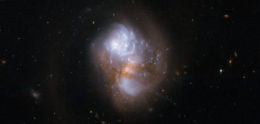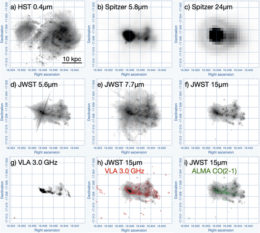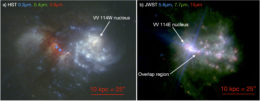There’s more to interacting galaxies than what meets the eye — and luckily, telescopes across the electromagnetic spectrum can reveal what our eyes can’t see. What can recent JWST observations tell us about the source of the infrared emission from the interacting galaxy pair VV 114?
A Partially Shrouded Interaction

Optical image of the interacting galaxies in VV 114 taken by the Hubble Space Telescope. The galaxies are shown in the same orientation as in the cover image. [NASA, ESA, the Hubble Heritage (STScI/AURA)-ESA/Hubble Collaboration, and A. Evans (University of Virginia, Charlottesville/NRAO/Stony Brook University)]
Although astronomers have studied the infrared light from these interacting galaxies before, JWST is able to resolve substantially finer details than previous infrared space telescopes — and that means gaining a better understanding of where and how the galaxies’ infrared emission is generated.

Images of VV 114 from the Hubble and Spitzer space telescopes (top row), JWST (middle row), and the Very Large Array (VLA) and the Atacama Large Millimeter/submillimeter Array (ALMA) (bottom row). Click to enlarge. [Evans et al. 2022]
Infrared Investigation
A team led by Aaron Evans (University of Virginia) obtained new observations of the VV 114 galaxies with JWST’s Mid-Infrared Instrument (MIRI) at wavelengths of 5.6, 7.7, and 15 microns (1 micron = 10-6 meter). These observations showed that the bright nucleus of VV 114E contains two cores separated by about 2,050 light-years, and one of these two cores is itself divided into two components.
Previous radio-wavelength observations suggested that one of VV 114E’s nuclear cores contains an active galactic nucleus: a supermassive black hole that is accreting gas from its neighborhood. Intriguingly, the new JWST observations suggest that the proposed active galactic nucleus–containing core is actually a star-forming region — but the other core might host an active galactic nucleus instead!
Star-Forming Regions Abound

Comparison of visible-light observations of VV 114 by the Hubble Space Telescope (left) with mid-infrared observations of the galaxy pair with JWST (right). VV 114E’s bright nucleus and many star-forming regions become visible in the JWST image. Click to enlarge. [Evans et al. 2022]
The authors also noticed an abundance of emission in the 7.7-micron band, which encompasses emission from polycyclic aromatic hydrocarbons — molecules that consist of multiple rings of carbon atoms — indicating that the light from young stars is exciting these molecules throughout the galaxy. Future work, including analysis of spatially resolved spectra of the galaxy, will likely produce more details to consider — stay tuned!
Citation
“GOALS-JWST: Hidden Star Formation and Extended PAH Emission in the Luminous Infrared Galaxy VV 114,” A. S. Evans et al 2022 ApJL 940 L8. doi:10.3847/2041-8213/ac9971

